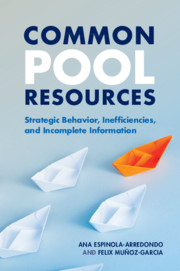Book contents
- Frontmatter
- Contents
- List of Figures
- List of Matrices
- Preface
- 1 Introduction
- 2 Common Pool Resources in a Static Setting
- 3 Common Pool Resources in a Dynamic Setting
- 4 Entry Deterrence in the Commons
- 5 Repeated Interaction in the Commons
- 6 Commons under Incomplete Information
- 7 Signaling in the Commons
- Appendix A Game Theory Tools
- Appendix B Solutions to Selected End-of-Chapter Exercises
- Bibliography
- Index
3 - Common Pool Resources in a Dynamic Setting
Published online by Cambridge University Press: 03 August 2023
- Frontmatter
- Contents
- List of Figures
- List of Matrices
- Preface
- 1 Introduction
- 2 Common Pool Resources in a Static Setting
- 3 Common Pool Resources in a Dynamic Setting
- 4 Entry Deterrence in the Commons
- 5 Repeated Interaction in the Commons
- 6 Commons under Incomplete Information
- 7 Signaling in the Commons
- Appendix A Game Theory Tools
- Appendix B Solutions to Selected End-of-Chapter Exercises
- Bibliography
- Index
Summary
INTRODUCTION
In this chapter we examine another form of inefficiency in CPRs. While Chapter 2 analyzed a staticinefficiency – that emerged when firms ignore the negative externality that their current appropriation imposes on other firms’ current costs – this chapter explores a dynamicinefficiency, arising from firms ignoring the negative externality that their current appropriation imposes on other firms’ futurecosts.
For presentation purposes, we consider a sequential-move game where, in the first period, only one firm operates in the CPR (e.g., the incumbent), but in the second period two firms compete for the resource (the incumbent and an entrant). This stylized setting helps us isolate the dynamic inefficiency that the incumbent's firstperiod appropriation imposes on the entrant's second-period costs, separating it from the static inefficiency that arises from the two firms’ simultaneous appropriation of the CPR in the second period. Our analysis can be extended to settings with two or more firms operating in both the first and second period, which gives rise to static inefficiencies in each period (where equilibrium appropriation is socially excessive) and a dynamic inefficiency across periods (as every firmignores the negative externality that its first-period appropriation has on its rivals’ future costs), and to contexts where two or more firms interact during more than two periods.
This chapter considers, for simplicity, the entrant's decision as exogenous, that is, the entrant has either joined or not joined the CPR. In subsequent chapters, however, we make this entry decision endogenous, that is, we allow for the potential entrant to evaluate whether entry is profitable. Interestingly, we will also examine which actions the incumbent can take during the first period to prevent entry of potential competitors, and how these actions can, paradoxically, protect the resource from overexploitation or, at least, ameliorate aggregate appropriation.
MODELING CPRS IN A DYNAMIC SETTING
How can we alter the basic setting presented in Chapter 2 to account for dynamic effects in the CPR? In a two-period sequential-move model, every firm ichooses its individual appropriation xi , facing a cost function similar to that in Chapter 2:
Information
- Type
- Chapter
- Information
- Common Pool ResourcesStrategic Behavior, Inefficiencies, and Incomplete Information, pp. 34 - 51Publisher: Cambridge University PressPrint publication year: 2021
